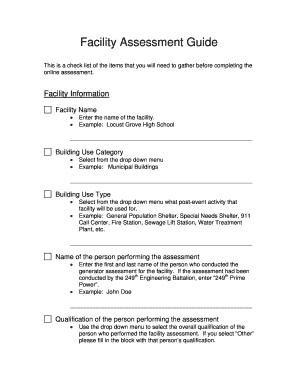
Get Guide - Emergency Power Facility Assessment Tool
How it works
-
Open form follow the instructions
-
Easily sign the form with your finger
-
Send filled & signed form or save
How to fill out the Guide - Emergency Power Facility Assessment Tool online
This guide provides clear and comprehensive instructions on how to fill out the Guide - Emergency Power Facility Assessment Tool online. By following these steps, users can efficiently complete the assessment form while ensuring all necessary information is included.
Follow the steps to successfully complete the assessment tool.
- Click the ‘Get Form’ button to access the online form and open it for editing.
- Enter the facility name in the designated text field, for example, 'Locust Grove High School'.
- Select the building use category from the drop-down menu, such as 'Municipal Buildings'.
- From the dropdown, choose the building use type that best describes the post-event activity for the facility, for example, 'General Population Shelter'.
- Input the name of the person performing the assessment, like 'John Doe'.
- Select the qualifications of the assessor from the dropdown options. If 'Other' is selected, provide the specific qualification.
- Choose the state where the assessor received their credentials from the drop-down menu.
- Fill in the date the assessor received their credentials in the designated format.
- Input the date when the assessment was performed. If unknown, use the date of form entry.
- Indicate whether an existing on-site backup generator is present by selecting 'Yes' or 'No'.
- Specify if an alternate generator can be connected using the established hookups, responding with 'Yes' or 'No'.
- Enter the complete physical address of the facility, review the Google Map for accuracy, and adjust the marker if necessary.
- Input the city, state, county or parish, and zip code for the facility.
- Provide the latitude and longitude for the facility’s location, either by accepting the auto-generated values or entering manually.
- Upload a photo of the facility front, ensuring it is in an acceptable format and within size limits.
- Fill out the primary/alternate point of contact information, including name, title, and contact details.
- In the generator information section, enter the generator location description, phase, configuration, load size, and other pertinent details.
- Provide any notes regarding on-site placement for the generator, and upload required photos.
- If there are additional generators to report, indicate this in the given section.
- After completing all fields, save the changes, and choose to download, print, or share the completed form.
Begin filling out the Guide - Emergency Power Facility Assessment Tool online today.
To perform an emergency generator load test, start by ensuring the generator is properly installed and all safety checks are complete. Next, connect a suitable load bank, running the generator at various load levels for specific durations, while monitoring its performance. This process helps confirm that your generator operates effectively and aligns with the standards outlined in the Guide - Emergency Power Facility Assessment Tool, ensuring reliability when you need it most.
Industry-leading security and compliance
-
In businnes since 199725+ years providing professional legal documents.
-
Accredited businessGuarantees that a business meets BBB accreditation standards in the US and Canada.
-
Secured by BraintreeValidated Level 1 PCI DSS compliant payment gateway that accepts most major credit and debit card brands from across the globe.


